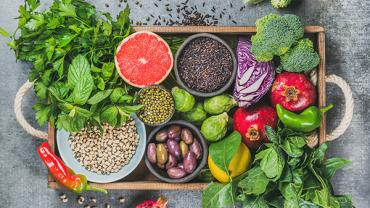
The body’s acid/base balance has a significant influence on health, but it doesn’t usually get much attention unless a blood chemistry panel reveals a distinct imbalance. Subtle deviations in this balance may not always be apparent on lab work, but they can be a factor in long term health. Kidney disease, bone loss, sarcopenia, insulin resistance, inflammation, cardiovascular disease, hypertension and non-alcoholic hepatic steatosis have all been linked to the body’s acid/base balance.
The kidneys and respiratory system are the primary means by which the body maintains a normal pH. Endogenous acid (produced primarily through metabolic processes) is expelled through respiration as CO2, whereas acid in the form of excess H+ ions must be excreted by the kidneys in the form of ammonium. All practitioners are well-versed in these processes, but we might not appreciate the crucial role of mineral buffers and other dietary factors in maintaining a healthy acid/base balance. Diets high in animal proteins, dairy and sugar, and low in fresh fruits and vegetables, tip the body’s pH toward a state of chronic metabolic acidosis. This change is sometimes small enough to remain undetected in bloodwork, but large enough to have adverse effects on health. Subclinical manifestations are easy to overlook, so it’s prudent for practitioners to consider a patient’s diet and the adequacy of dietary acid/base mineral buffers.
A healthy blood pH is within the range of 7.35–7.45, to avoid metabolic acidosis (blood pH lower than 7.35) or alkalosis (pH higher than 7.45). However, just as many conventional “normal” lab reference ranges are broad enough to include those who may experience subclinical symptoms, a functionally healthy pH is much narrower than this range suggests.
It is the diet that acts to shift the pH between these “normal” ranges. Acid-producing foods are higher in phosphorus and proteins (which contain acidic sulfur amino acids, such as cysteine, methionine, and taurine, and cationic amino acids such as lysine and arginine). Salt is a significant issue, as sodium chloride may exert approximately 50–100% of the acidosis-producing effect of the dietary acidic load. Alkalinizing foods, including most fruits and vegetables, contain higher bioavailable amounts of the buffering minerals calcium, magnesium, and potassium.
The blanket statement is sometimes made that most foods of animal origin are acid-producing, while most foods of plant origin are alkalinizing. This does not imply that foods of animal origin are unhealthy, but it suggests that high-protein diets that derive the majority of their protein from animal foods should be balanced with a generous intake of alkalinizing vegetables.
Dietary acid/base balance is typically measured using the potential renal acid load (PRAL) in combination with an estimated excretion value of organic acids. The PRAL is an estimation of the intestinal absorption rate of the contributing nutrients, the ionic balance of calcium, magnesium and potassium, and the dissociation of phosphate at pH 7.4. An alkalizing effect will be reached with a more negative PRAL. Meats (beef, pork, or poultry), cheese, eggs, beans, oilseeds, and grains have the greatest excretion value of organic acids, while fruits and vegetables have the smallest value, indicating an alkalinizing effect.
Too often, the mainstream approach to lowering net acid excretion in the body is to reduce protein intake. However, a healthier and more practical approach may be to increase vegetable and fruit intake. In a study of individuals with chronic kidney disease, increasing fruit and vegetable intake (without changing protein intake) could lower net acid excretion by approximately 30 percent. Low-grade, subclinical metabolic acidosis can precipitate chronic kidney disease.
What does the scientific literature show regarding the relationship between disease and low-grade metabolic acidosis induced by diet?
Kidney Health
As mentioned earlier, dietarily induced low-grade metabolic acidosis is associated with chronic kidney disease and age-related kidney decline. It has been proposed that this effect is a result of tubular toxicity from elevated ammonium concentrations. Increased ammonia production in the proximal tubule increases H+ excretion distally to augment overall acid excretion. But limited nephron function makes it challenging to keep up with the demand. Adequate potassium helped to offset this demand and buffer the acidity, but sadly, many diets lack adequate potassium, found primarily in vegetables and fruit.
Blood Pressure
Kidney function influences blood pressure. Low-grade metabolic acidosis can be linked to hypertension indirectly, and some studies show a direct association. The Nurses’ Health Study II involved over 87,000 women with no history of hypertension. This prospective study examined the relationship between diet-dependent net acid load (estimated net endogenous acid production) and risk of hypertension. It was found that women in the top decile of estimated diet-dependent net acid load had increased risk for hypertension compared to women in the bottom decile.
Type 2 Diabetes
Recent studies are linking dietary acid load with insulin resistance and type 2 diabetes. In a cross-sectional study of 104 adults, insulin sensitivity was measured by hyperinsulinemic-euglycemic clamp and compared to PRAL and net endogenous acid production. Fasting plasma lactate levels changed inversely with the glucose infusion rate, indicating that mild metabolic acidosis is associated with insulin resistance and can be induced by dietary acid load in healthy humans. A 2016 review concluded that a diet with a high acid load may lead to the development of insulin resistance, and that reducing the acid load may be protective and prevent the onset of type 2 diabetes. A 2018 systematic review and meta-analysis of prospective observational studies concluded, “Adherence to a diet with high acid-forming potential might increase the risk of type 2 diabetes.” Other issues that have been significantly but weakly linked to a high dietary acid load include increased waist circumference, higher BMI, and higher blood pressure.
If something as simple as eating more vegetables and fruits to lower the dietary acid load can have such a significant impact on health, maybe parents and grade school health classes were right all along: we should eat more vegetables and fruits.